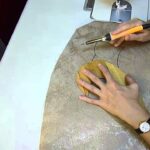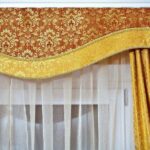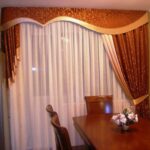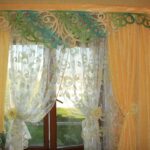Basics of making openwork lambrequins
There are plenty of options for decorating your interior. One of the most commonly used is the original window opening finish. In addition to the main curtains, decorative cords, holders and openwork lambrequins are used.

Features of openwork lambrequins
Openwork lambrequins began to be used in interior design in the second half of the 19th century. This accessory began its modern history quite recently.
Lace, carved on an openwork lambrequin, is very reminiscent of cutwork embroidery, looks unusually airy and elegant. Such a "bar" will harmoniously complement any style: from luxurious baroque to modern hi-tech and minimalism.
This part of the curtain design is always made of hard materials (plastic or wood), and then supplemented with any decorative elements. Another name for these lambrequins is bando. They are made in the technique of laser processing of materials to order. But this is a very expensive pleasure, so most people prefer to purchase a ready-made decorative strip for the cornice: outwardly, it is a tape with a repeating pattern, from which you can cut the desired length and fix it in the upper part of the curtains.

If desired, an openwork lambrequin can be made with your own hands. This will require the source material and a set of tools. And then everything depends only on your "golden" hands and imagination.
There are two types of gangs:
- One-piece construction made for a specific window.
- A combined element of several shaped parts. Most often it consists of three parts: two mirrored extreme and one central. If the window opening is not too large, and the entire structure cannot be placed, someone prefers to confine himself to only the central fragment. And if the window opening is too large, then there may be more than two side strips.
Another important nuance: not in every room you can install an openwork lambrequin. Much depends on the climatic features of the room and its functional purpose. So, the gang will have to be abandoned in the kitchen, with the exception of those rooms in which the latest hoods, air conditioning and ventilation systems are installed. Otherwise, a greasy coating will be very noticeable on the surface of the decorative element, and in some cases the coating may swell or deform.

In the bathroom, there is also no place for openwork lambrequins. The atmosphere of high humidity and high temperatures will certainly have a detrimental effect on the appearance of the decor.
Manufacturing technology
To create an openwork lambrequin yourself, you need to prepare well:
- You should start by looking for a stencil. Today, all kinds of drawings and sketches for every taste can be found on the Internet, and then just print the version you like and cut it out. If the drawing that you like is not large enough, try enlarging the monogram using graph paper, and then transferring it to a more durable material. Whatman paper or wallpaper is perfect for creating a template.
Important! Before you start drawing, straighten the sheet by placing heavy objects on it, otherwise the template may turn out to be crooked.
- Having prepared the blank, transfer the drawing to the bando base. Self-adhesive or hot-melt options are available today.
- Now is the time to use the main decorative material. The main thing is that the fabric is synthetic, natural canvases for the manufacture of openwork lambrequins will not work. Make sure that the material does not "crumble", otherwise the bando will soon look sloppy. In addition, the material must be dense enough to keep its shape. More often than others, an atlas is used to create openwork lambrequins. Before gluing the fabric to the base of the gang, iron it well, otherwise wrinkles and irregularities will appear on the surface. Glue the fabric to the base, depending on the type of bandeau you choose. Usually the technological process of gluing is extremely simple: the fabric is ironed first with steam, and then without it.
- Edge processing. It is better to decide at the very beginning how exactly you will process the edge of the resulting product. In this respect, laser cutting is beyond competition, since in addition to a smooth cut, you get a kind of sealed edge.
- Burning out. This is another great way to get a beautiful and neat lambrequin as a result. The technology of creating openwork patterns on fabric using burning (or, guilloche) appeared relatively recently, however, it has already "gathered" its army of admirers. This method is much more practical and simpler than laser cutting, especially since many have a burning device at home.
- An overlock or sewing machine is the easiest way to process the edge of an openwork lambrequin with high quality. In this case, you need to add seam allowances (about 2 cm on each side). If you decide to process the edge with a bias tape, then no allowances are required. The main disadvantage of this processing option is the impossibility of obtaining a perfectly flat edge. In addition, this method is within the power of very patient craftsmen, since everything is done manually. Finally, this method of overcasting is not applicable in the case of patterns that are too airy and thin.
- If desired, a lining can be glued to the seamy side of the lambrequin. However, in most cases, the bando from the seamy side looks quite neat, and additional operations are not required.
Recommendations for making a bando:
- It is not recommended to make a felt base, as the material is too hard. But the dublerin will allow you to create graceful shapes. The design is slim and neat.
- You can trim along the edge not only with an oblique inlay, but also with piping. It looks stylish, focuses on the pattern, and helps to hide the uneven edges.
- Feel free to use additional decor to decorate the bandeau. For example, decal will add "life" to the calm color of the lambrequin. Decorative flowers on a lace background look very impressive. Also at your disposal are embroidery and stencil decorations for additional finishing of the carved ornament.
- To make the lambrequin fit not only into the curtain ensemble, but also harmoniously complement the overall design concept of the interior, complement it with finishing elements such as cord hooks. Choose your color scheme carefully: an openwork golden lambrequin looks appropriate in a room with gilded handles and a headboard.
- When buying a ready-made openwork lambrequin, choose the correct repetition step. The drawing can have a "rapport" from 1 meter to 4.5 meters. And buy the bando a little with a margin as with its help you need to hide the corners of the cornice.
- Curtain rods with rounded sides are ideal for attaching gangs. You do not have to buy a lambrequin with a margin.
- It is necessary to take into account the shape of the window and the shape of the room. A too narrow window visually seems wider if you use a wide lambrequin, and hang the curtains themselves in such a way that they cover part of the space near the window.
- Using a lambrequin in the entire wall in a narrow room, you will visually make the room wider.
- If the room has low ceilings, it is better to refuse to install the gang. But if you really want to, choose the most delicate "light" model.
- Airy openwork is the lot of classics and baroque. If you are decorating a room in modern minimalist styles, give preference to more "dense" lambrequins.
How to care for an openwork lambrequin
Any interior item needs care, and openwork lambrequins are no exception. Carved bandeau is not recommended to be washed, and in general it is better to avoid any contact with a humid environment. But such structures are easy to dry clean. Dust and dirt are removed with a cloth brush.

In case of severe contamination, it is recommended to make a gruel from washing powder and water (you can also use a washing gel, but you do not need to dilute it). Remove the pelmet, lay it on the floor and apply the cleaning agent directly to the place of heavy dirt. Wait 10-15 minutes and use a brush to scrub the stain. You need to use the brush very carefully so that the lambrequin does not deform. The remnants of the product are removed with a soft sponge, and the lambrequin itself is ironed several times with an iron.

The correct use of openwork lambrequins will not only add zest to the interior, making it unique in its kind, but will also adjust the space if necessary.
Video: do-it-yourself openwork lambrequin










































































